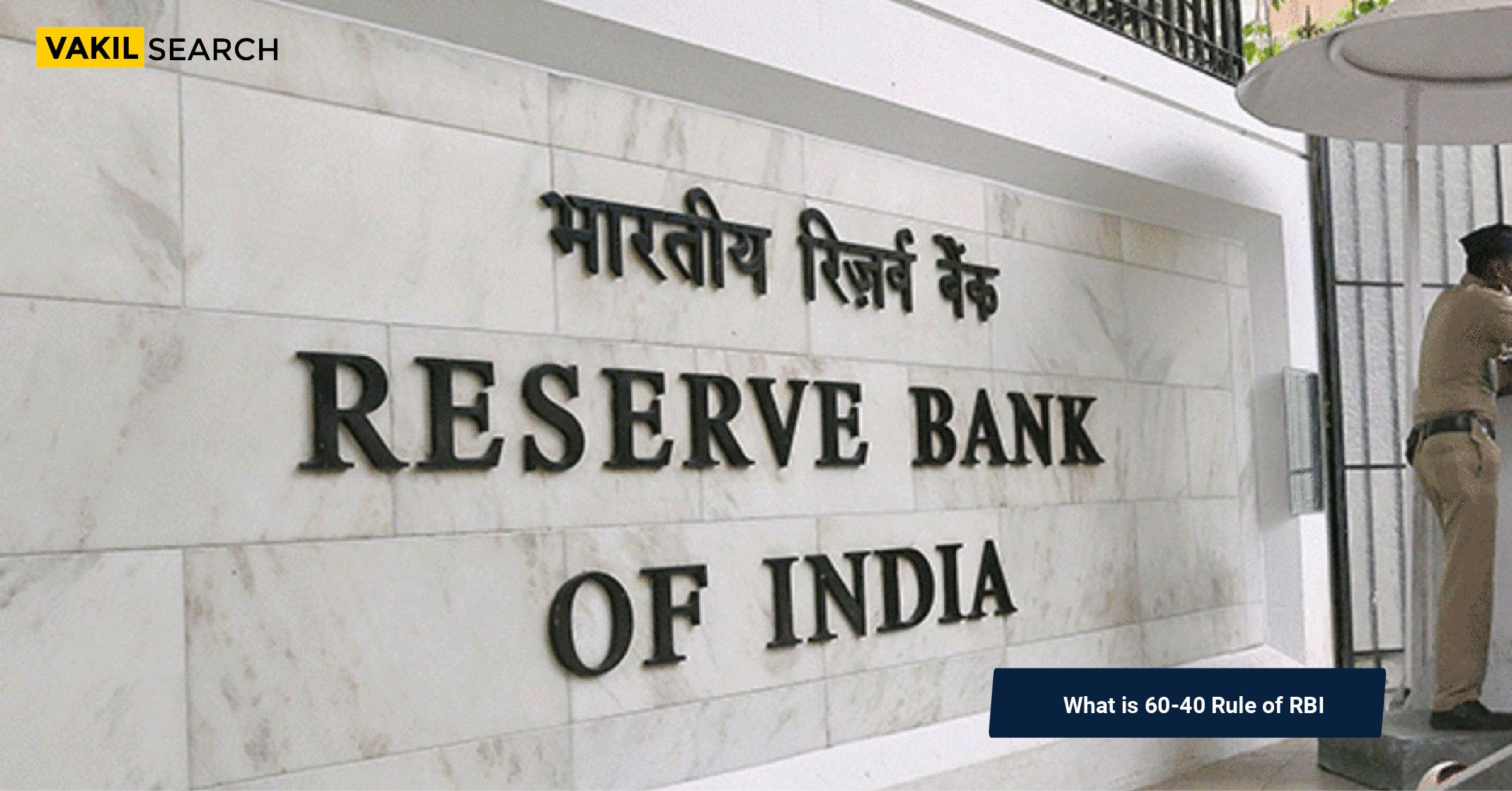Uncover RBI's 60-40 Rule: Explore its significance and implications in this informative guide. Know more about the rules and regulation from legal experts. Read now
The Reserve Bank of India (RBI) is the country’s central banking institution, and its policies play a crucial role in shaping the financial sector. One of the lesser-known but significant regulations imposed by the RBI is the ’60-40 rule.’ In this blog, we will explore the concept of the 60-40 rule, understand its objectives, and discuss its impact on the financial health of banks.
What is the 60-40 Rule?
The 60-40 rule, often referred to as the ‘Dividend Distribution Policy,’ is a regulation imposed by the RBI on Indian banks. This rule mandates that banks must distribute a minimum of 40% of their annual net profits as dividends to their shareholders, while the remaining 60% can either be retained or used to strengthen the bank’s capital adequacy.
Objectives of the 60-40 Rule
The RBI introduced the 60-40 rule with several key objectives in mind:
Balancing Profit Distribution: The primary goal is to ensure that banks distribute a reasonable portion of their profits to shareholders. This encourages banks to be accountable to their investors and promotes transparency in financial operations.
Capital Adequacy: By retaining 60% of their profits, banks can bolster their capital adequacy ratios. Adequate capital is vital for absorbing unexpected losses and safeguarding depositors’ interests.
Stability: The rule aims to maintain the stability of the banking sector by preventing banks from excessively distributing profits, which could weaken their financial position during economic downturns.
Encouraging Growth: The 60-40 rule strikes a balance between rewarding shareholders and allowing banks to reinvest in growth opportunities, such as expanding their operations or adopting new technologies.
Impact on the Financial Health of Banks
The 60-40 rule has a profound impact on the financial health of banks, both positive and negative, depending on their adherence and economic conditions.
Positive Impact of 60-40 Rule
Strengthening Capital Base: Retaining 60% of profits enables banks to build a robust capital base. This serves as a buffer against unexpected losses and enhances the bank’s resilience during challenging times.
Investment in Technology: Banks can allocate retained profits for technological advancements, allowing them to stay competitive and provide better services to customers.
Long-Term Sustainability: By not excessively distributing dividends, banks can ensure their long-term sustainability, reducing the risk of financial crises.
Negative Impact of 60-40 Rule
Reduced Attractiveness for Investors: Banks that consistently retain a large portion of their profits may become less attractive to investors seeking regular dividends. This could impact their stock prices and market perception.
Liquidity Constraints: During periods of economic stress, banks may find it challenging to maintain liquidity if a significant portion of their profits is locked in retained earnings.
Impact on Shareholders: Shareholders, especially those relying on dividends for income, may be disappointed by lower payouts. This can affect the bank’s stock valuation and investor sentiment. It’s important to note that the impact of the 60-40 rule can vary from bank to bank based on their individual financial positions and strategies.
Regulations and Notifications: This section often contains official notifications and circulars related to banking regulations, including the 60-40 rule.
Reports and Publications: The RBI publishes annual reports and financial stability reports, which may include insights into the impact of regulations on the banking sector.
Banking Supervision: This section provides information on the RBI’s supervisory role over banks, which includes policies and guidelines related to dividend distribution.
The Historical Context on 60-40 Rule
The 60-40 rule, as a dividend distribution policy, has its roots in the global financial crisis of 2008. During that period, many banks across the world faced severe financial distress, leading to the collapse of several financial institutions. In India, the RBI recognized the importance of fortifying the country’s banking sector against similar vulnerabilities.
Striking a Balance
The 60-40 rule underscores the delicate balance between the interests of shareholders, who seek dividends as a return on their investments, and the broader financial stability of the banking sector. It ensures that banks do not prioritise short-term gains over long-term resilience. This is especially crucial in an era of economic volatility and uncertainty, where banks must be equipped to weather various financial storms.
Promoting Prudent Banking Practices
Beyond dividend distribution, the 60-40 rule promotes prudent banking practices. Banks are encouraged to maintain a healthy proportion of their profits as retained earnings, which serves as a financial cushion. This cushion can be used to absorb unforeseen losses, adhere to regulatory capital requirements, and support growth initiatives. In essence, it compels banks to adopt a forward-looking approach to their financial management.
Regulatory Adaptability
While the 60-40 rule provides a clear framework, it is not rigid. The RBI allows for flexibility in exceptional circumstances. For instance, during economic downturns, banks may be permitted to reduce dividends further to conserve capital and ensure stability. This adaptability showcases the RBI’s responsiveness to the dynamic nature of the financial markets.
Investor Confidence
Investors often view the adherence to the 60-40 rule as a sign of prudent and responsible banking. When a bank consistently complies with this regulation, it sends a positive signal to investors, indicating that the bank prioritises long-term stability and is less likely to engage in risky practices that could jeopardise their investments.
Conclusion
The RBI’s 60-40 rule is a critical regulation that influences how banks in India manage their profits and distribute dividends. By striking a balance between rewarding shareholders and ensuring capital adequacy, this rule aims to maintain the stability and sustainability of the banking sector. It’s essential for banks to navigate this rule effectively, considering their unique financial positions and long-term growth objectives.
Understanding the 60-40 rule is crucial for investors, policymakers, and anyone interested in the Indian banking sector’s dynamics. It represents a key aspect of financial governance that plays a pivotal role in shaping the future of India’s banking industry. For more such information on the subject make sure to get in touch with Vakilsearch.










